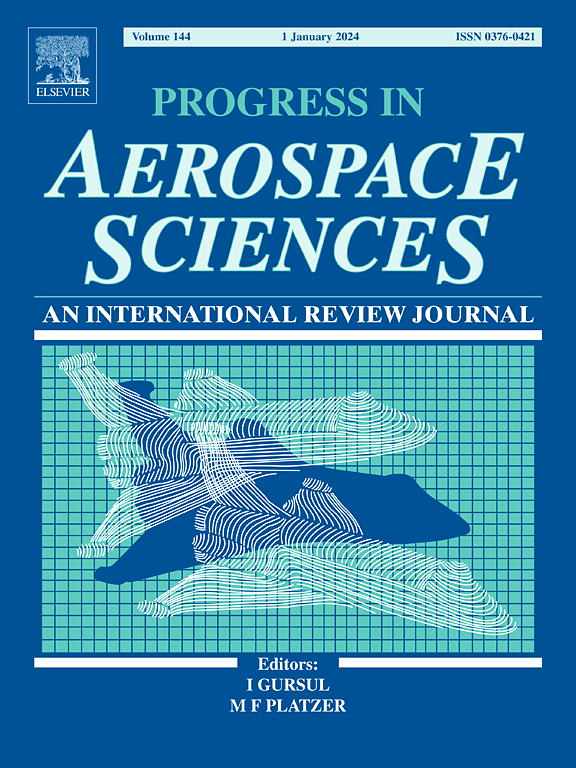A Scientometric Investigation of Artificial Intelligence for Fluid Mechanics: Emerging Topics and Active Groups
IF 16.2
1区 工程技术
Q1 ENGINEERING, AEROSPACE
引用次数: 0
Abstract
Fluid mechanics, as one of the core disciplines of engineering technology, faces dual challenges of theoretical limitations and high computational costs when addressing complex flow problems, promoting the integration of artificial intelligence into the field. This paper systematically reviews the paradigm shift in fluid mechanics driven by AI technologies. Through a bibliometric analysis of 18,776 relevant publications up to May 2025 from the Web of Science Core Collection, we investigated the interdisciplinary intersection between two keyword sets: 22 artificial-intelligence-related terms (including Machine Learning, Neural Networks, Symbolic Regression, Reinforcement Learning, etc.) and 22 fluid-mechanics-related terms (including CFD, Aerodynamics, Fluid-Structure-Interaction, etc.). Our systematic investigation employs a modeling-computation-application framework to analyze this interdisciplinary field, presenting the most active countries, institutions, research groups, and leading scholars while mapping the overall research landscape. Key findings include: (1) From 2000 to 2014, the number of publications and citations grew slowly, but since 2014, both have shown a significant increase. (2) AI applications in fluid mechanics are categorized into modeling (dimensionality reduction and knowledge discovery, machine learning-based turbulence modeling), computation (reduced-order models and feature extraction, machine learning-based CFD simulations), and applications (data fusion and reconstruction, multi-physics and multi-disciplinary coupling, intelligent flow control, aerodynamic shape optimization). (3) The United States dominates foundational research, while China leads in technological applications. (4) Multi-dimensional network analysis—including author, institutional, and national collaboration networks, along with co-citation patterns—reveals a pronounced spotlight effect among leading global universities and research teams. The twenty representative teams selected from them have important value in the academic and engineering fields and deserve further attention. This study provides a clear and comprehensive framework for researchers in the field and offers guidance for future research in intelligent fluid mechanics.
流体力学中人工智能的科学计量学研究:新兴主题和活跃群体
流体力学作为工程技术的核心学科之一,在解决复杂流动问题时面临理论局限性和计算成本高的双重挑战,推动了人工智能与该领域的融合。本文系统地回顾了人工智能技术推动的流体力学范式转变。通过对Web of Science核心馆藏截至2025年5月的18,776篇相关出版物的文献计量分析,我们调查了两个关键字集之间的跨学科交叉:22个与人工智能相关的术语(包括机器学习、神经网络、符号回归、强化学习等)和22个与流体力学相关的术语(包括CFD、空气动力学、流体-结构-相互作用等)。我们的系统调查采用建模-计算-应用框架来分析这一跨学科领域,展示最活跃的国家、机构、研究小组和主要学者,同时绘制整体研究景观。主要发现包括:(1)2000 - 2014年,论文发表量和被引量增长缓慢,但自2014年以来,两者均呈现显著增长。(2)人工智能在流体力学中的应用分为建模(降维和知识发现、基于机器学习的湍流建模)、计算(降阶模型和特征提取、基于机器学习的CFD仿真)和应用(数据融合与重构、多物理场和多学科耦合、智能流动控制、气动外形优化)。(3)美国在基础研究方面占主导地位,中国在技术应用方面处于领先地位。(4)多维网络分析——包括作者、机构和国家合作网络,以及共引模式——揭示了全球领先大学和研究团队之间明显的聚光灯效应。从中选出的20个代表性团队在学术和工程领域具有重要价值,值得进一步关注。本研究为该领域的研究人员提供了一个清晰、全面的框架,并为未来智能流体力学的研究提供了指导。
本文章由计算机程序翻译,如有差异,请以英文原文为准。
求助全文
约1分钟内获得全文
求助全文
来源期刊

Progress in Aerospace Sciences
工程技术-工程:宇航
CiteScore
20.20
自引率
3.10%
发文量
41
审稿时长
5 months
期刊介绍:
"Progress in Aerospace Sciences" is a prestigious international review journal focusing on research in aerospace sciences and its applications in research organizations, industry, and universities. The journal aims to appeal to a wide range of readers and provide valuable information.
The primary content of the journal consists of specially commissioned review articles. These articles serve to collate the latest advancements in the expansive field of aerospace sciences. Unlike other journals, there are no restrictions on the length of papers. Authors are encouraged to furnish specialist readers with a clear and concise summary of recent work, while also providing enough detail for general aerospace readers to stay updated on developments in fields beyond their own expertise.
 求助内容:
求助内容: 应助结果提醒方式:
应助结果提醒方式:


